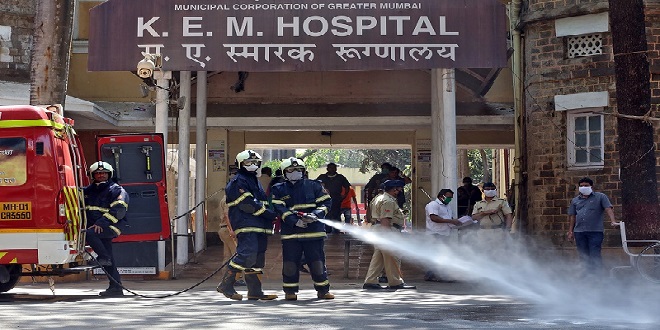While COVID-19 ravages the world, little is known about the disease’s spread in India’s rural hinterland and congested urban areas. More importantly, how is it being managed? Will India follow a similar, or even worse trajectory as China, Italy and Iran? What would that mean in a country of 1.3 billion people, which is often depicted as bumbling and chaotic, with poor health facilities and desperately short of medical manpower?

Perhaps India’s saviour may not be a miraculous vaccine, but the efficiency of its administration and public health responses to a crisis.
Two-thirds of India’s 1.3 billion population is rural, spread over 728 districts in about 650,000 villages. By Tuesday (31 March) evening, 1397 cases had been reported, with 146 new infections in the past 24 hours across the country – and a death toll which rose to 35. This, despite taking stout measures long before most people were even aware of how lethal this disease could be and the way it affects human beings, who can easily succumb once it spreads in the community.

Health Crisis Management at the District & State Levels
India ordered an early embargo on international arrivals, including Indian citizens, and cancelled all domestic flights. The Indian Railways, which annually carries the equivalent of the entire world’s population, imposed draconian checks on movement. A nation-wide lockout was imposed on 25 March, banning people from leaving their homes – except in pairs, only for essential provisions and medicine.
Under the Indian Constitution, health is governed at the State level. But when it comes to epidemic control, the Health Ministry’s directives must be and indeed are observed by all states. With the enforcement of the National Disaster Management Act 2005, the administrative system has been reinforced. Indeed, political wrangling has abated considerably, as all states have understood what is at stake.

How COVID-19 Crisis Was Managed in Bhilwara, Rajasthan
To understand how COVID-19 gets managed on the ground, consider the district of Bhilwara in Rajasthan (total population 2.7 million) — which has been in the news because of a COVID-19 infected private hospital doctor along with 12 of his hospital staff. A relatively sleepy, largely rural district in one of India’s poorer states, Bhilwara was only known for textiles and scroll paintings. The doctor and staff who had all tested positive have been in isolation. How has Bhilwara – headlined by the BBC as “India’s possible Italy?” – responded? By 26 March, over two million people in the district —88 percent of the population — had been surveyed through house-to-house visits.
The DM was certain of 100 percent coverage by 28 March. This was indeed achieved, and the entire 26 lakh-plus population of the district has been combed through, followed by quarantining hundreds of families and putting them under daily surveillance – both on phone and in person.
A third survey of the urban areas of the district, as well as a second survey of the rural areas, is underway. A list of beds which have been prepared in hotels, resorts, boarding lodges and the district hospital were provided immediately to me.
The first surveys showed influenza-like symptoms in 2,572 persons in urban areas, but now it has been reported that the number has plummeted to 842 in the second urban survey. Positive cases are beginning to test negative.

Using Records of National Immigration & Railway Authorities Effectively
What about other states? The Indian states of Jharkhand, Chhattisgarh and Odisha are ranked in the lowest cohort of states by the UNDP’s Human Development Index 2018. In all three states, front-line health workers visit quarantined cases day and night. Each suspected case, which meets the risk threshold, is transported by ambulance to the nearest health centre, where samples are drawn, and the suspect and his family are quarantined until the test report is generated. Health Secretaries of all three states corroborate that this continues daily.
Cases were first identified using the records and manifestos of national immigration and railway authorities. The Integrated Disease Surveillance programme, run by the National Centre for Disease Control, tracks the hot spots through a call centre-based reporting system that was first deployed during the H1N1 outbreak in 2010.
The district administration itself runs electronically over mobile phones. In the health sector alone, four groups operate: at the interstate level, within districts, between contiguous districts, and between health Secretaries of the states and the Union Health Secretary – all on phone.
Things can go out of hand as happened suddenly in Delhi with the exodus of thousands of migrants back to their villages. They travelled on foot or anything moving. The reasons why this happened would need more than what this article can include, but the good news is that they are being identified, quarantined and checked – even fed and given shelter – not in thousands but tens of thousands.
India’s COVID-19 Fight Is Using Enormous Human Resources & Technical Prowess
India is actively combating COVID-19 in a way unknown to other countries using enormous human resources and technical prowess.
The Centre, the states and the districts are linked electronically, and the Health Ministry and top officials run daily video conferences.
A generous economic package covering cash transfers, food, pensions and cooking gas has been announced for all poor people who will pay nothing out of pocket. A government sponsored insurance package has been announced for all health workers. Langars (akin to soup kitchens in the west) for anyone hungry have commenced. In Delhi, measures to serve food to everyone who wants it are to begin across the wards by Wednesday, 1 April.
The latest to throw a huge spanner in what appeared to be a manageable story is the news of a congregation of a very large number of people in Nizamuddin, Delhi which has resulted in several confirmed COVID-19 cases. The visitors had travelled to India from other countries and infected people who have since travelled to different states. This was a totally unwarranted assembly, given that an embargo on any gathering of more than 50 people was announced from 13 March in Delhi – long before the countrywide lockdown came into force.

Deep Roots of Indian Administration Will Leave No Stone Unturned
Once again, the public health machinery has started combing operations which will now need to penetrate not just to find those who participated in the congregation but who have infected contacts and contacts of contacts.
To ferret them out is once again dependent on a meticulous public health response – the success of which cannot be forecast. But not for want of trying.
The COVID-19 crisis will certainly worsen. But it should be everyone’s hope that even as our most trustworthy research organisations, the most experienced clinicians and scientific institutions work in unison, the deep roots of the Indian administrative and public health system will leave no stone unturned in detecting infections and tackling them as set out in the Health Ministry’s directions.
We must salute all the people who are making this happen, and join hands in gratitude that India possesses the leadership, expertise and commitment that this situation demands. This is not the time to berate anyone – least of all the states and districts.
(Shailaja Chandra (IAS retd) has over 45 years experience of public administration focusing on governance, health management, population stabilisation and women’s empowerment. She was Secretary of the Department of Indian Systems of Medicine & Homeopathy, Ministry of Health &Family Welfare (1999-2002) and following that the Chief Secretary Delhi until 2004. She tweets at @over2shailaja. This is an opinion piece and the views expressed are the author’s own. The Quint neither endorses nor is responsible for them.)
We’ll get through this! Meanwhile, here’s all you need to know about the Coronavirus outbreak to keep yourself safe, informed, and updated.


